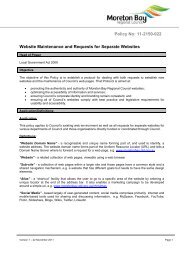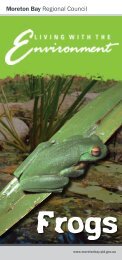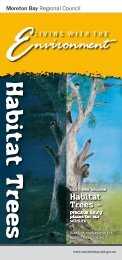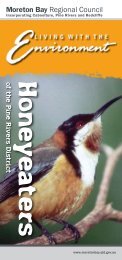Lantana - Moreton Bay Regional Council
Lantana - Moreton Bay Regional Council
Lantana - Moreton Bay Regional Council
- No tags were found...
You also want an ePaper? Increase the reach of your titles
YUMPU automatically turns print PDFs into web optimized ePapers that Google loves.
FireRegular burning will reduce the capacity of plants tosurvive; however, initial kill rates are variable.The effectiveness of this method will depend onthe suitability of available fuel loads, fire intensity,temperature, relative humidity, soil moisture and season.Pasture re-establishment can then provide competition toinhibit lantana seed germination.Fire is not recommended in non–fire tolerant vegetatedareas such as rainforest, or wooded or plantation areas.A typical control program for fire may include:• exclude stock to establish a pasture fuel load• burning (may require a permit)• sow improved pastures—consult your local BiosecurityQueensland officer for advice• continue to exclude stock until pasture has establishedand seeded• burn again in summer before rain and spot spraylantana regrowth when > 0.5 m high and when it isactively growing (see Table 1).Herbicide controlHerbicide recommendations for lantana are shown in Table1. Users of herbicides have a legal obligation to readherbicide labels and use only the registered rates. Alwaysuse herbicides responsibly; adhere to legislation andsafety requirements.Variation in results can be a result of inconsistent applicationmethods, mix rates or seasonal variation. Red-floweredand pink-edged red-flowered lantana are often consideredthe most difficult to control because their leaves are oftensmaller and tougher. However, herbicides can kill thesevarieties if you carefully follow application procedures.For single-stemmed lantana, basal bark spraying and cutstump methods also give good results at any time of year(but best when the plant is actively growing). On multistemmedvarieties, you will obtain best results by carefullyapplying herbicide to each stem.When treating actively growing plants less than 2 mhigh, overall spraying of foliage to the point of run-off isrecommended. Splatter gun techniques are also effectiveand particularly useful in hard-to-access areas. This is bestdone in autumn—when sap flows draw the poison down intothe root stock, but before night temperatures get too cold.Remove grazing animals from spray areas during and soonafter treatment. Stress can cause increased sugar levels inthe leaves of lantana plants, making them more palatable.Landholders and contractors should check if the propertyis situated in a hazardous area. This prevents the use ofsome chemicals, as defined in the Agricultural ChemicalsDistribution Control Act 1966.Biological controlSince 1914, 31 biological control agents have beenintroduced into Australia in an attempt to control lantana.Seventeen have established, of which several insectspecies cause seasonal damage, reducing the vigour andcompetitiveness of lantana in some areas.Biosecurity Queensland research programs continue toinvestigate agents suitable for release in Australia, andtest the viability of these agents in an effort to identifymore effective biological control agents.It is important to remember that biological controlalone should not be relied upon for managing lantanainfestations. Consideration should be given to otheravailable control techniques.The four most important biological control agents are:• sap-sucking bug (Teleonemia scrupulosa)Found in dry areas from Cooktown to Wollongong, thissmall, mottled, bug feeds on the underside of leaves,growing tips and flower buds, causing the leaves todrop early and stopping the plant from flowering.• leaf-mining beetle (Uroplata girardi)Found in most lantana infestations from CapeTribulation to Sydney as well as around Darwin, exceptin very dry or high altitude areas. The adult beetles aredark brown. They shelter in curled leaves and feed onthe upper leaf surfaces. Larvae feed in leaves causingblotches to spread across the leaf. This beetle reducesplant vigour and can suppress flowering.• leaf-mining beetle (Octotoma scabripennis)Found in most lantana infestations from Atherton toWollongong. Adults of this species feed on the upperleaf surface, while larvae feed and mine the centre ofthe leaf and cause blotches. This activity reduces plantvigour and can suppress flowering.• seed-feeding fly (Ophiomyia lantanae)Found from Cape Tribulation to Eden in New South Walesand also around Darwin and Perth. Ophiomyia is a smallblack fly that feeds on flowers and lays eggs on the greenfruits. The maggots of the fly eat the seed and make thefruit unattractive to birds, reducing seed spread.Other agents such as Aconophora compressa (a stemsuckingbug) and Leptobyrsa decora (a sap-sucking bug)have caused some damage in specific geographic areas.Note: Landholders are advised not to consume their timecollecting established insects for distribution. Due to theirown ability to disperse, these insects will be periodically/seasonally present in areas that are climatically suitablefor them.Further informationFurther information is available from your localgovernment office, or by contacting BiosecurityQueensland (call 13 25 23 or visit our website atwww.biosecurity.qld.gov.au).3 <strong>Lantana</strong> <strong>Lantana</strong> camara


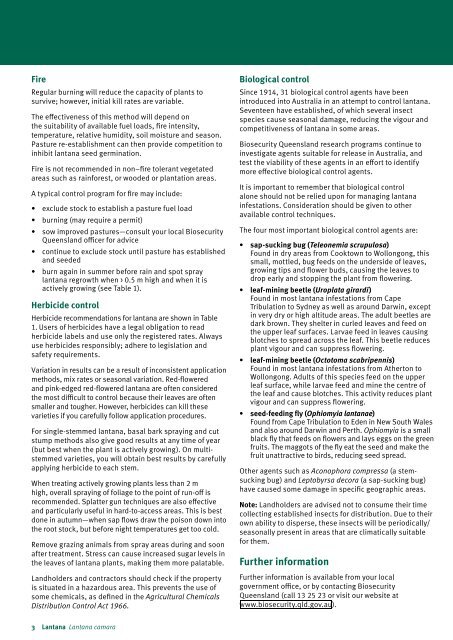
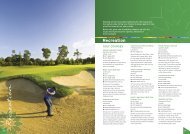

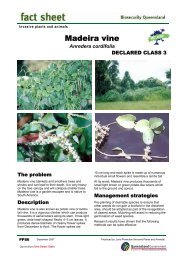
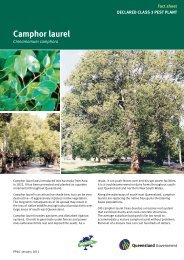


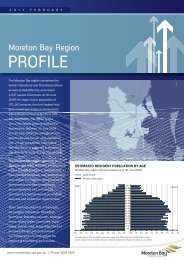
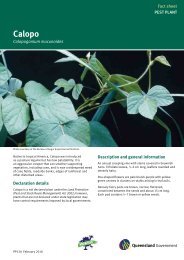
![Kumbartcho Brochure [PDF 540KB] - Moreton Bay Regional Council](https://img.yumpu.com/47220970/1/190x101/kumbartcho-brochure-pdf-540kb-moreton-bay-regional-council.jpg?quality=85)
